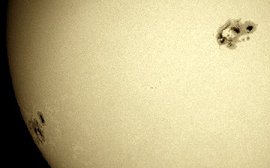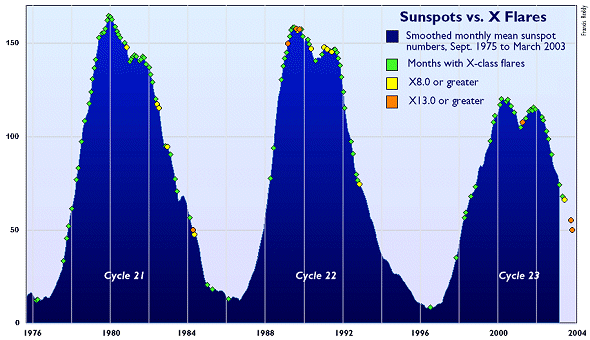The Sun Goes Haywire

Solar maximum is years past, yet the sun has been remarkably active lately. Is the sunspot cycle broken?

 Listen
to this story via
streaming audio, a
downloadable file, or
get help.
Listen
to this story via
streaming audio, a
downloadable file, or
get help.
November 12, 2003:Â Imagine you're in California. It's July, the middle of summer. The sun rises early; bright rays warm the ground. It's a great day to be outside. Then, suddenly, it begins to snow--not just a little flurry, but a swirling blizzard that doesn't stop for two weeks.
That's what forecasters call unseasonal weather.
It sounds incredible, but "something like that just happened on the sun," says David Hathaway, a solar physicist at NASA's Marshall Space Flight Center.
Only a few weeks ago solar activity was low. The face of the sun was nearly blank--"very few sunspots," says Hathaway--and space weather near Earth was mild. "Mild is just what we expect at this point in the 11-year solar cycle," he explains. "The most recent maximum was in 2001, and solar activity has been declining ever since."
 Then,
suddenly, in late October the sun began to behave strangely. Three
giant sunspots appeared, each one larger than the planet Jupiter. In
California where smoke from wildfires dimmed the sun enough to look
straight at it, casual sky watchers were startled by the huge
blotches on the sun. One of them, named "sunspot 486," was the
biggest in 13 years.
Then,
suddenly, in late October the sun began to behave strangely. Three
giant sunspots appeared, each one larger than the planet Jupiter. In
California where smoke from wildfires dimmed the sun enough to look
straight at it, casual sky watchers were startled by the huge
blotches on the sun. One of them, named "sunspot 486," was the
biggest in 13 years.
Right: Astrophotographer Bob Sandy of Virginia took this picture of giant sunspot 486 emerging over the sun's limb on Oct. 23, 2003. It is preceded by another giant spot, numbered 484. [more]
Sunspots cause solar flares and, usually, the biggest flares come from the biggest spots. The three giant sunspots unleashed eleven X-class flares in only fourteen days--equaling the total number observed during the previous twelve months. "This was a big surprise," says Hathaway.
The effects on Earth were many: Radio blackouts disrupted communications. Solar protons penetrated Earth's upper atmosphere, exposing astronauts and some air travelers to radiation doses equal to a medical chest X-ray. Auroras appeared all over the world--in Florida, Texas, Australia and many other places where they are seldom seen.
Researchers rank solar flares according to their x-ray power output. C-flares are the weakest. M-flares are middling-strong. X-flares are the most powerful. Each category has subdivisions: e.g., X1, X2, X3 and so on. A typical X-flare registers X1 or X2. On Nov. 4th, sunspot 486 unleashed an X28 flare--the most powerful ever recorded.
 Left:
An extreme-ultraviolet telescope onboard the orbiting Solar and
Heliospheric Observatory (SOHO) captured this false-color movie of
the Nov. 4, 2003, X28 superflare near the sun's limb. [more]
Left:
An extreme-ultraviolet telescope onboard the orbiting Solar and
Heliospheric Observatory (SOHO) captured this false-color movie of
the Nov. 4, 2003, X28 superflare near the sun's limb. [more]
"In 1989 a flare about half that strong caused a widespread power blackout in Quebec," recalls Hathaway. Last week's blast was aimed away from Earth, so its effects on our planet were slight--a bit of good luck.
All this happened two years after solar maximum, which raises a question: is something wrong with the solar cycle? Is the sun going haywire?
"Nothing's wrong," reassures Hathaway. The sun isn't about to explode, nor is the sunspot cycle broken. "These latest sunspots were whoppers," he allows, "but sunspot counts averaged over many weeks are still declining as predicted. We're still on course for a solar minimum in 2006."
Indeed, it's possible that what we've just experienced is a normal part of the solar cycle, speculates Hathaway. "There's a curious tendency for the biggest flares to occur after solar maximum--on the downslope toward solar minimum. This has happened during two of the last three solar cycles." The plot below illustrates his point.
Below: Using data archived by NOAA's Space Environment Center, Francis Reddy created this plot of sunspot number and X-class solar flares during the last three solar cycles.

Consider the year 1984, says Hathaway. Sunspot counts were plunging, and the sun was rapidly approaching the 1985-86 solar minimum. Suddenly a giant sunspot appeared, Jupiter-sized like sunspot 486, and unleashed two dozen M-flares and three X-flares, including a remarkable flare registering X13. People then probably wondered too if the solar cycle was broken.
"It's hard to be sure what's normal and what's not," notes Hathaway. "Astronomers have been observing x-rays from the sun for only 35 years--or three solar cycles. We can't draw good statistical conclusions from so few data."
|
Sunspot 486 and its companions are on the far side of the sun now, carried around by the sun's 27-day rotation. "We suspect they're still active," says Hathaway, because the Solar and Heliospheric Observatory--a sun-watching satellite--has photographed clouds of gas being thrown over the sun's limb by unseen explosions. Unless these sunspots dissipate, which could happen, they will reappear on the Earth-facing side of the sun beginning as early as Nov. 14th.
And then...? No one knows. "We might get some more unseasonal space weather," says Hathaway. But this time he won't be surprised.
more information
Sunspot Cycle Predictions -- (Science@NASA) from solar physicist David Hathaway
Solar Superstorm -- (Science@NASA) Scientists are beginning to understand a historic solar storm in 1859.
History's Biggest Solar Flares -- (SpaceWeather.com) Three of the top ten were unleashed by sunspot 486.
What is an "X-class" Solar Flare? -- (SpaceWeather.com)
The Hydro-Quebec Blackout of March 1989 -- On March 13, 1989, a transformer failure on one of the main power transmission lines in the HydroQuebec system precipitated a collapse of the entire power grid. The cause was a geomagnetic storm.
Geomagnetic Storms Can Threaten Electric Power Grid -- The sprawling North American power grid resembles a large antenna, attracting electrical currents induced by giant solar storms.
SpaceWeather.com -- current information about solar activity and auroras
NOAA Space Environment Center -- the US government's official source of space weather data and forecasts
Join our growing list of subscribers - sign up for our express news deliveryand you will receive a mail message every time we post a new story!!!
More Headlines
Headlines
THE END
